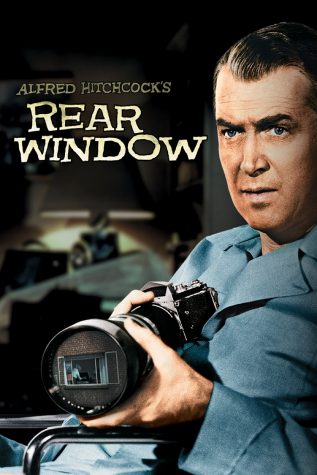Movie Mondays 1: Rear Window (1954)

With the end of 2014 marking its 60th anniversary, coupled with my personal love for the film, Rear Window made an excellent choice as the first entry in the Stinger’s new Movie Mondays series.
Rear Window, a quintessential film directed by the master of suspense, Alfred Hitchcock, focuses on the story of a photographer with a broken leg who suspects one of his neighbors of murder.
The film takes place entirely from the view of the photographer’s rear window, which pans out on his neighbors’ tenement buildings. The photographer is cooped up in his apartment and confined to a wheelchair due to a broken leg. Out of boredom and lack of things to do, he becomes sort of a peeping Tom, using his camera’s lens and binoculars to peer into the lives of his neighbors. One day, however, the seemingly innocent activity turns sinister when the photographer witnesses one of his neighbors murdering his wife, and makes plans to expose him.
The photographer is played by James Stewart (1908-1997), a recurring actor in many Hitchcock films. Stewart plays his part with the signature likability that his characters are famous for, lending his character both funny and serious personas and switching among the two fluently. Unlike most movie protagonists today, the character is not big-muscled and gun-toting, simply because he doesn’t need to be. Stewart’s performance makes it easy for the audience to believe that the character is merely a normal guy who happened to stumble upon a series of unfortunate events. The audience slowly begins to care about the photographer, while the movie’s eventful plot line forces one to wonder, what would I do in this situation?
The film also stars Grace Kelly (1929-1982) as Lisa Fremont, the love interest to Stewart’s photographer. Kelly plays a stereotypical 50’s female who makes abounding efforts to marry the photographer while he resists her advances. Nonetheless, there are some instances where Fremont takes risks and does not wait for a man to save her, such as when she goes into the suspected murderer’s apartment to search for evidence.
Hitchcock was in his finest form while directing this film. The excellent setting of the film, which takes place entirely in the photographer’s apartment, creates the paradoxical atmosphere of both claustrophobia and safety. Additionally, the action all takes place in a community in which everyone lives close to one another, making the idea of a murderer among them all the more terrifying.
The film’s set was extremely impressive, accurately portraying apartments and a courtyard. The small nature of the set piece almost makes the audience feel as if they are watching a play.
The side characters, mainly the photographer’s neighbors, are all quite memorable. Despite not having much screen time, each of the neighbors has a distinct personality, and a few even have character arcs throughout the film.
The suspense in this film is palpable, and makes even the action of looking out the window just as scary as a killer with a knife. There is a great sense of danger, and a couple of close-shave type situations that will leave you breathless. There are also a few comedic moments that are nicely interspersed with the tension, making sure that the viewer can have some humorous relief from the suspense. There is no gore or violence in the film; however, the dialogue leaves it to the audience to imagine and visualize the gore themselves.
Rear Window absolutely ranks among Hitchcock’s greatest works, just under his later, most famous film, Psycho (1960). The film has had a profound influence on the television and film industries throughout the years, being re-imagined in the film Disturbia (2007), parodied in a 1994 episode of The Simpsons entitled Bart of Darkness, and most recently, making a cameo as a poster in Peter Parker’s bedroom in The Amazing Spider-Man (2012).
Rear Window, a film that has just celebrated its 60th birthday, is still enjoyed today. I have no doubt it will stand up just as well when its 120th year anniversary rolls around.

Hi, I'm Sam Falconer. I'm a senior this year, so, yeah. Anyway, I am a film connoisseur and an avid reader and writer. I am also a lover of all things...

















































































![Senior Ditch Day... Relaxation or Truancy? [Video]](https://achsstinger.com/wp-content/uploads/2017/10/IMG_7119-900x599.jpg)
![Heavy Rain Hits Cam High [video]](https://achsstinger.com/wp-content/uploads/2017/02/maxresdefault-900x506.jpg)


